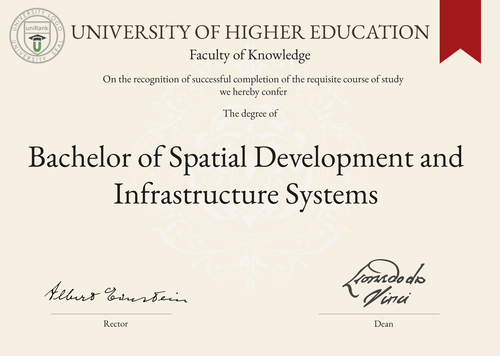
Bachelor of Spatial Development and Infrastructure Systems (B.SpatialDev&InfraSys)
Guide to University Programs/Courses
Bachelor of Spatial Development and Infrastructure Systems (B.SpatialDev&InfraSys)

Program/Course Name
Bachelor of Spatial Development and Infrastructure SystemsProgram/Course Abbreviation
B.SpatialDev&InfraSysDuration Range
3-4 yearsTuition range
Varies by country and universityOverview
The Bachelor of Spatial Development and Infrastructure Systems program is designed to provide students with a comprehensive understanding of spatial planning, development and infrastructure systems. This interdisciplinary program combines elements of urban planning, geography, environmental studies and engineering to equip students with the skills and knowledge necessary to address the complex challenges of urban and regional development.Curriculum Overview by Year
Year 1: Introduction to Spatial Development, Geographic Information Systems, Urban Planning FundamentalsYear 2: Infrastructure Systems, Land Use Planning, Transportation PlanningYear 3: Sustainable Development, Spatial Analysis, Project ManagementYear 4: Advanced Topics in Spatial Development, Internship/Practicum, Capstone ProjectKey Components
- Spatial Planning and Development- Geographic Information Systems (GIS)- Urban and Regional Infrastructure Systems- Sustainable Development- Project ManagementCareer Prospects
Graduates of the Bachelor of Spatial Development and Infrastructure Systems program can pursue various career paths in both public and private sectors. Potential career options include:- Urban Planner- GIS Specialist- Transportation Planner- Environmental Consultant- Infrastructure Project ManagerSalary Expectations
Salary expectations for graduates of the Bachelor of Spatial Development and Infrastructure Systems program can vary depending on factors such as location, industry and level of experience. On average, professionals in this field can expect a competitive salary range. For a more accurate understanding of salary expectations, you can utilize the Job Sites Search Engine, from our sister site jobRank, which searches over 4,600 job sites worldwide. Make sure to specify not only the job title but also the country you are interested in.Conclusions
It is important to note that the duration, tuition fees, curriculum, key components, career prospects and salary expectations of the Bachelor of Spatial Development and Infrastructure Systems program can vary based on the chosen country or location of study, as well as the specific university offering the program. Prospective students are encouraged to research and compare different universities and countries to find the best fit for their academic and career goals. Visitors can search for where this specific degree, Bachelor of Spatial Development and Infrastructure Systems, is offered anywhere in the world through the uniRank World Universities Search Engine.World Universities Search Engine
search for Bachelor of Spatial Development and Infrastructure Systems (B.SpatialDev&InfraSys) and add the Location (country, state etc.) or specific University you are interested in studying at.
Query examples:
- Bachelor of Spatial Development and Infrastructure Systems (B.SpatialDev&InfraSys) United States
- Bachelor of Spatial Development and Infrastructure Systems (B.SpatialDev&InfraSys) United Kingdom online
- Bachelor of Spatial Development and Infrastructure Systems (B.SpatialDev&InfraSys) Australia international students
- Bachelor of Spatial Development and Infrastructure Systems (B.SpatialDev&InfraSys) University of California
- Bachelor of Spatial Development and Infrastructure Systems (B.SpatialDev&InfraSys) University of London tuition fees
- Bachelor of Spatial Development and Infrastructure Systems (B.SpatialDev&InfraSys) University of Sydney scholarships